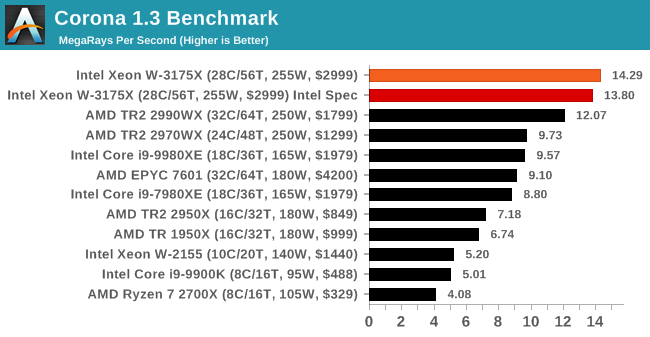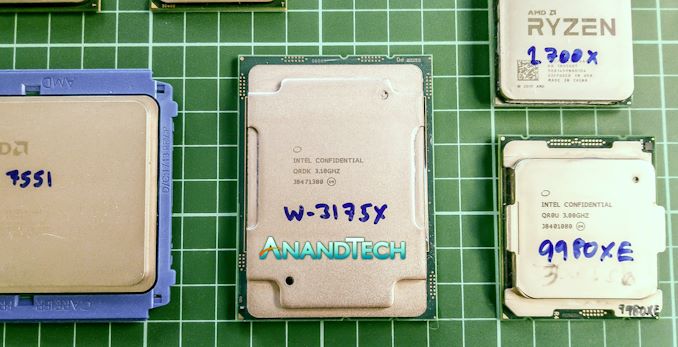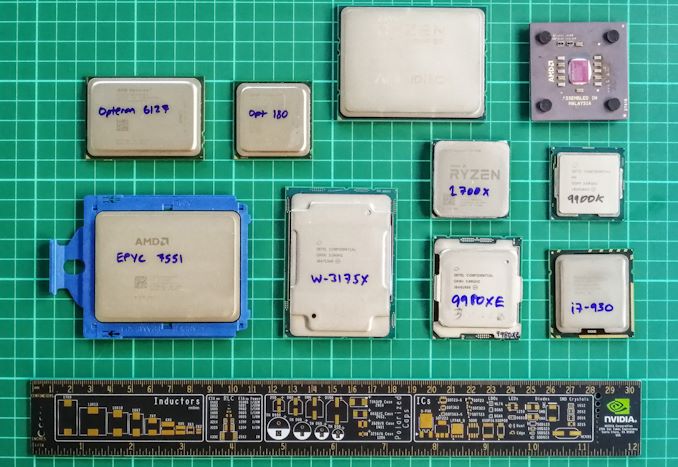The Intel Xeon W-3175X Review: 28 Unlocked Cores, $2999
by Ian Cutress on January 30, 2019 9:00 AM ESTConclusion: Price Makes Perfect
When you buy a system, ask yourself – what matters most to you?
Is it gaming performance?
Is it bang-for-buck?
Is it all-out peak performance?
Is it power consumption?
Is it performance per watt?
I can guarantee that out of the AnandTech audience, we will have some readers in each of these categories. Some will be price sensitive, while others will not. Some will be performance sensitive, others will be power (or noise) sensitive. The point here is that the Xeon W-3175X only caters to one market: high performance.
We tested the Xeon W-3175X in our regular suite of tests, and it performs as much as we would expect – it is a 28 core version of the Core i9-9980XE, so in single threaded tests it is about the same, but in raw multi-threaded tests it performs up to 50% better. For rendering, that’s great. For our variable threaded tests, the gains are not as big, from either no gain at all to around 20% or so. This is the nature of increasing threads – at some point, software hits Amdahl’s law of scaling and more threads does nothing. However, for software that isn’t at that point, the W-3175X comes in like a wrecking ball.

For our graphs, some of them had two values: a regular value in orange, and one in red called 'Intel Spec'. ASUS offers the option to 'open up' the power and current limits of the chip, so the CPU is still running at the same frequency but is not throttled. Despite Intel saying that they recommend 'Intel Spec', the system they sent to us to test was actually set up with the power limits opened up, and the results they provided for us to compare to internally also correlated with that setting. As a result, we provided both sets results for our CPU tests.
For the most part, the 'opened up' results scored better, especially in multithreaded tests, however Intel Spec did excel in memory bound tests. This is likely because in the 'opened up' way, there is no limit to keeping the high turbo which means there could be additional stalls for memory based workloads. In a slower 'Intel Spec' environment, there's plenty of power for the mesh and the memory controllers do deal with requests as they come.
Power, Overclockability, and Availability
Two-and-a-half questions hung over Intel during the announcement and launch of the W-3175X. First one was power, second was overclockability, and two-point-five was availability.
On the power side of the equation, again the W-3175X comes in like a wrecking ball, and this baby is on fire. While this chip has a 255W TDP, the turbo max power value is 510W – we don’t hit that at ‘stock’ frequency, which is more around the 300W mark, but we can really crank out the power when we start overclocking.
This processor has a regular all-core frequency of 3.8 GHz, with AVX2 at 3.2 GHz and AVX-512 at 2.8 GHz. In our testing, just by adjusting multipliers, we achieved an all-core turbo of 4.4 GHz and an AVX2 turbo of 4.0 GHz, with the systems drawing 520W and 450W respectively. At these frequencies, our CPU was reporting temperatures in excess of 110ºC! This processor is actually rated with a thermal shutoff at 120ºC, well above the 105ºC we see with regular desktop processors, which shows that perhaps Intel had to bin these chips enough that the high temperature profile was required.
On the question of availability, this is where the road is not so clear. Intel is intending only to sell these processors through OEMs and system integrators as part of pre-built systems only, for now. We’ve heard some numbers about how many chips will be made (it’s a low four-digit number), but we can only approximately confirm those numbers given one motherboard vendor also qualified how many boards they were building.
One of Anand’s comments I will always remember during our time together at AnandTech was this:
“There are no bad products, only bad prices.”
According to OEMs we spoke to, initially this processor was going to be $8k. The idea here is that being 28-core and unlocked, Intel did not want to consume its $10k Xeon market. Since then, distributors told us that the latest information they were getting was around $4500, and now Intel is saying that the recommended consumer price is $3000. That’s not Intel’s usual definition of ‘per-1000 units’, that’s the actual end-user price. Intel isn’t even quoting a per-1000 unit price, which just goes to substantiate the numbers we heard about volume.
At $8000, this CPU would be dead in the water, only suitable for high-frequency traders who could eat up the cost within a few hours of trading. At $4500, it would be a stretch, given that 18-core on Intel is only $2099, and AMD offers the 32-core 2990WX for $1799 which surpasses the performance per dollar on any rendering task.
At $2999, Intel has probably priced this one just right.
At $2999, it's not a hideous monstronsity that some worried it would be, but instead becomes a very believeable progression from the Core i9-9980XE. Just don’t ask about the rest of the system, as an OEM is probably looking at a $7k minimum build, or $10k end-user shelf price.












136 Comments
View All Comments
silverblue - Thursday, January 31, 2019 - link
Future bought the bulk of Purch not too long ago, but if it's same old same old, then I agree.Cooe - Wednesday, January 30, 2019 - link
Until these benches are all repeated in Linux all of these results are wortheless. Nobody would buy these CPU's for a Windows machine, and the 2990WX is totally borked by running in Windows as well.WasHopingForAnHonestReview - Wednesday, January 30, 2019 - link
True but the 2990WX is 1300$ cheaper and gives roughly the same performance. No one is going to buy this intel chip unless they have money to burn.maroon1 - Wednesday, January 30, 2019 - link
Same performance ?! Did you look a the benchmarks ?! w-3175x is cleary winning in majority of benchmarks (and some benchmarks should big advantage for w-3175x)I agree about price, but performance is not same
MattZN - Wednesday, January 30, 2019 - link
It depends on what precise application(s) you are running. But yes, the performance is about the same. Those benchmarks are pretty broken for a host of reasons... windows scheduler nonwithstanding, looking at a bunch of benchmarks doesn't really tell you a whole lot about how a machine will work in your actual environment.All that matters is whether the machine's performance affects your workflow in a noticeable way or not. Nobody is going to justify buying something like this if all they get out of it is a 15 minute faster encoding on a 2-hour job. Imagine that! Let alone a few seconds here and there, or a slightly slower or faster frame rate. For longer jobs you'll notice if something takes half the time. You won't notice if something is 20% slower or 20% faster. You just won't.
Many video encoding workloads are GPU accelerated, for example. Many are run as overnight batches, for example. If you go through all the benchmarks in this article, almost none of them are even remotely relevant to actual use cases. The Blender one maybe, Handbrake, and Adobe Premier and that's just about it. And surprise, surprise, the TR2950X or TR2990WX actually wins some of those.
For example, does anyone actually care how fast 7-zip runs? I sure as heck don't! I zip something up, it's well neigh instantaneous on just about any machine. Encryption? Nobody cares, it isn't a use case that anyone will notice. Office applications like spreadsheets? Come on... that's ridiculous. A 2-core mobile CPU can update a spreadsheet just as fast as one of these behemoths.
-Matt
GreenReaper - Thursday, January 31, 2019 - link
It does kinda matter for server-level ctivities. Say you have a SQL dump that you want to backup without using too much transfer. You can't run nightly backups until it's done. Even compressed it's 4GB. I use xz but it's essentially the same as 7-zip. More threads and faster threads can make a significant difference in run time, and in turn this impacts when you can backup or how much data you can handle on the system.I think you may be mistaken about the 20% difference if it effectively means you have to pay 20% more people. The question, as always, is is the price and other costs associated worth the improvement.
FMinus - Friday, February 1, 2019 - link
Why would you do any of that on this chip that sucks 600W, for all of your listed task a dedicated server chip would be better, you run them in batches over night as said, so the speed really does not matter at that point.This chip here is intended as a workstation work horse, and yes, with the price of the single chip and the expensive motherboards (which we still don't know if they will be available to the end-user directly) makes this an quite pointless platform, except if you are running Adobe Premiere 24/7.
For everything else you are better of with the cheaper AMD and Intel solutions, and you can get multiple systems of those for the price of one of these 3175X systems, split the work load or make them work together and they deliver faster results.
tamalero - Friday, February 1, 2019 - link
Not everyone has access to full blown server rendering farms. A lot of remote workers or freelancers would render with this "behemoth". Not everyone can blow 10,000 USD to have a bunch of EPYC servers just standing by.Still.. This thing doesnt seem THAT good compared to AMD's (both price, performance and power usage) to justify it.
only the AVX512 benches I guess.
But then.. Zen2 is supposed to double the output of AVX if I remember correctly.
WasHopingForAnHonestReview - Thursday, January 31, 2019 - link
7zip and some specific renders... The time saving isnt much. Its not even close to make this a worthwhile buy. When you take into account the windows scheduler bug fix coming... The amd TR for $1300 is still the obvious winner.eddman - Wednesday, January 30, 2019 - link
"No one is going to buy this intel chip unless they have money to burn."So it's not "No one" then.
I suppose 3D modeling and rendering studios or individuals that have lots of customers will probably be quite ok with buying these. That price is nothing compared to their income. They probably care more about reducing rendering time than saving a few thousand dollars, which they can recoup in probably a week or two.